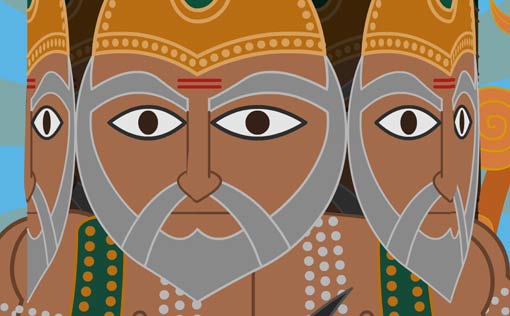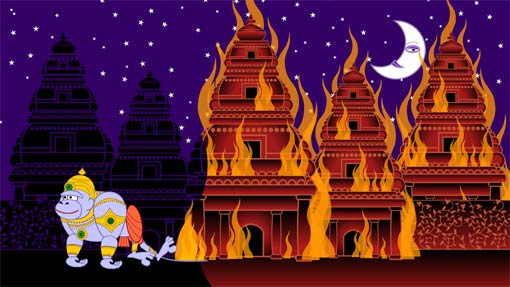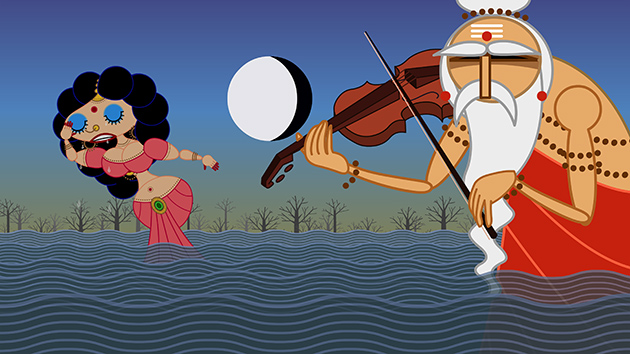
The Making of Nina Paley's Sita Sings the Blues
The result, three full years later, is Sita Sings the Blues, a tragic but buoyant, even inspiring film that juxtaposes Paley's own experiences with those of Sita, wife of Rama, who was abandoned by her husband over unfounded suspicions about her faithfulness. The story is told using several different animation styles, including mock-ancient paintings for the traditional story of Sita; a spare, comic-strip approach to the contemporary story of Nina; and a whimsical Flash-centric style for a more personal interpretation of Sita's story that uses simple shapes and cleverly layered animation loops to fill the screen with motion. There's a bit of rotoscoping in there, too. The film premiered at this year's Berlinale festival in Germany, and made a splash last month at the Tribeca Film Festival in New York. Watch the trailer, below, then read the Q&A.
F&V: After so many years of drawing comic strips, what was your impetus for getting into animation?
Nina Paley: I was burned out.
But you wanted to continue drawing?
I just wanted to do animation. I was burned out on comics. I was being paid to do mainstream dailies, and it became a job.
Sita Sings the Blues is all you, right?
Yes.
With any assistance?
Well, I worked with a sound designer, Greg Sextro, which was crucial. And there were the voices, which were also crucial. For four or six weeks in the summer of 2005, I had an apprentice. I was teaching him Flash while he worked on this. He came in a couple of days a week. And that was it.
Did you have any formal animation training?
No.
How did you even know how to approach it?
When I was 12 or 13, I borrowed a next-door neighbor's Super 8 camera. I got a book called The Animation Book, by Kit Laybourne, and I read the book and I used the camera. So I had a little bit of experience, but I abandoned it when I was 14. And I didn't touch animation again until I was 30 – 10 years ago. I picked up where I left off, with a Super 8 camera and clay and a stop-motion film called "Luv Is."
And then I started dating an animator — who is actually now my ex-husband — and he had an animation table with animation paper. I had never used an animation table before — it's amazing how much all this stuff has changed in the last 10 years. At work, he had access to a video line tester, so I did another little short film that way. In San Francisco, this band called Nik Phelps and the Sprocket Ensemble would do monthly performances of live music to animation. I did a Super 8 thing, Nik composed a score to it, and they were showing it. The next thing you know, I'm in this local indie-film world in San Francisco. They knew projectionists, so I met a projectionist who helped me find 35mm junk stock, and then I did scratching and drawing on 35mm junk stock. I bought a 16mm camera and shot my next clay film on 16. It just kept going.
I saw that at one point you painted a film on Imax stock. Was that actually shown in the Imax format?
There is a single 15-perf, 70mm print, which is genuinely, 100 percent camera-less. No optical printers or anything. I made that film through a lot of power schmoozing and begging and things like that. There's something called the Large Format Cinema Association. Once I heard that existed, I just went to their events and tried to meet people. The junk stock that I drew on was donated by an editor, and he helped me find a large-format splicer — which was $400 but new it would have been $2000 or something ridiculous — and helped me get reels. Just this cheap equipment and a bunch of junk stock, that's what I used. Through more schmoozing and begging, CFI Hollywood donated the processing and Kodak donated the print stock and the negative stock, so it was made mostly through donations. It's kind of a miracle, because I had never schmoozed like that before. I was so excited to think it was possible.
Did you know that Stan Brakhage painted a film on Imax stock? They commissioned it and he painted it, but they looked at it and they were, like, 'No, we won't be showing this.'
Yeah, that's too bad. I think Caroline Leaf also did one. But in both of those, I think there was an optical-printing process also involved. In the case of the Caroline Leaf film, it was on twos [one drawing for two frames of film]. There's no way to draw directly on film on twos. You can only do the on-twos on an optical printer. Mine was done with a contact-printing process. It was all on ones. I was adamant about that. They were very wary of doing the contact printing at CFI, but I said, "No, this is going to be cameraless!"
No optical processes.
The 35mm version had to go through an optical printer to do a shootdown, but for the Imax print, no lenses were used.
So Sita Sings the Blues is a feature film. It's obviously longer. It's got multiple styles of animation, several of which seem like a departure for you. I'm curious how you concepted that in your head.
It's a mystery. It's like the film wanted to be made, and I just did whatever I needed to do to get it made. It's so hard to describe how I chose it. Whatever worked. There was an issue of economy, because I didn't have money for it. And I had limited time as well. My slogan is, "Adequate is good enough." The design of the Annette Hanshaw pieces had a lot to do with economy. I designed that in Flash, which is software that I'm already familiar with, so I know what it's capable of. I made designs that I knew would be workable with the technology I had available – things that you could look at while I cut as many animation corners as possible. I put as much work into it as was necessary to carry the story and have enough visual interest, and no more than that.
You needed to be really efficient.
Right. And that sort of determined the styles. For the paintings, I wanted to use real Indian paintings, but I couldn't get access or permission. Those things all should be in the public domain, but they're jealously guarded by museums who claim to own them. But they shouldn't. That's not fair, that's not right. Those images were never copyrighted. But I didn't go into that. I just made my own fake paintings. They were all done in pieces, which I put together, but they were all painted by hand, by me, on this parchment.

You can see the texture of the paper in the close-ups.
That's why I did it this way. I looked into using software that would emulate paint, but I figured the best way to emulate paint is to use paint. It ended up taking a lot of time to make these things, which was frustrating. But on the positive side, all I had to animate was their little mouths going, and that was it. There was no other motion. I did little cheats, like I only painted half of this background and then I scanned it and flipped it to make the full background. Stuff like that. And now I want to sell these suckers somewhere.
You said you were going for the minimum necessary effort to make the Flash work, but the cleanness of the lines and in a way the economy of it is overwhelming. It scales up surprisingly well.
I put a lot of stuff into it. My idea of adequate is not necessarily someone else's idea of adequate. I get bored so easily watching animation and watching film that it had to meet minimum requirements to prevent my own boredom. It was made for my visual tolerance level. I put little tiny camera moves on everything. You can see objects getting bigger really subtly. That's just something I learned to add – tiny, tiny little tricks.

There were moments where you experimented with a semi-3D effect. In one scene, Sita was turning circles, and there are little in-between frames showing three-quarter views.
Yeah, where she's twirling. And then people think [Hindu god] Brahma's rotating head [is 3D]. That's just Flash. A lot of it was like, "I know this is possible." Some things turned out to be not as easy to figure out as I thought they would be. The flames, and the pattern of the water – they are really simple, but figuring out how to make them took several days of head-banging. The flames, boy howdy. The flames were made out of sine waves. I animated a sine wave moving in a cycle, and then I took two of them and I had them intersecting each other while they move, and then I cut pieces off.
You're cleverly layering looped animations.
Oh, yeah. I was thinking in Flash, so I knew what Flash was good at, and Flash is very good at looping. You can have a background that's alive if you work it right. You have one flame on a loop, and then you can change the size, flip it around, change the starting frame, and suddenly you have this fire that's very watchable.
Was the whole thing executed in Flash?
The talking paintings were After Effects, only because After Effects handles bitmaps better. If you do a slow zoom in After Effects, it'll be smoother than Flash. I think Flash moves raster images on whole pixels only, and After Effects moves them on half pixels. I just decided to bite the bullet and use After Effects, but I much prefer Flash. I edited everything in Final Cut Pro, so everything became a QuickTime movie.
How did you discover the music of Annette Hanshaw?
Well. I was dumped by my husband. I was staying on various sofas in New York City. One of the sofas belonged to Sherwin Dunner, who is an old-record collector. He had shelves full of records. The friend that was cat-sitting for him that let me stay on the sofa pulled some down and played them, and that was when I heard Annette Hanshaw and "Mean to Me" for the first time. I loved it and I wanted to hear it all the time, so that friend found and purchased for me an Annette Hanshaw CD from Canada. I played that all the time because I was wallowing in grief and I just loved those songs.
Did you have to pursue rights for those?
The recordings are not covered by federal copyright, but the underlying compositions are. So we are having to pay off the estates of the publishers. That's one of the many things I can't afford. They want money just for playing it in film festivals. It's like – how about if I give you a percent of the profits I get from film festivals? You can have 100 percent each. Which means that you'll be paying me, because the profits are negative. But no, I'm supposed to pay them. It costs $500 a song to play in festivals. So it's $5500 [for the 11 songs used in Sita]. Which is nothing for a real production. For me, it's just money I don't have. None of this is set up for independent filmmakers.

How about exhibiting it? For festivals, do you show it from HDCAM tape?
A 35mm print! Oh my goodness, yes, this puppy's on film.
Did you do the film-out when you started making the festival rounds?
Its world premiere was at the Berlinale. And Berlin only shows 35mm, at least in the section I was programmed in. I wanted to do a DCP [digital cinema package], and I was looking forward to doing a DCP, but they couldn't show a DCP at Berlin. So suddenly I had to make a 35mm print, and I had no money. So I posted on my blog that this had happened: "The good news is, I'm going to Berlin. The bad news is, I need $30,000." I actually ended up raising about $15,000 from strangers – some of them were friends, but people donated $15,000 that month. That was really freakin' exciting. I also got a freelance job around that time, and I borrowed money from friends and family. So I was able to make a 35mm negative and get the sound done, and we got a print.
Now there are three prints circulating. One of them is about to become a French-only print, because it's getting French subtitles burned into it for Annecy [the International Animated Film Festival, in Annecy, France], which only accepts 35mm prints with subtitles. It's all very expensive for an independent filmmaker. I am out of money and in debt and I have about $13,000 in bills coming. And I just have no idea how I'm going to pay for them.
And at the same time, you'd like to chase your film all around the world, wherever it's being shown.
That's not so expensive. I suppose what's expensive is that I'm spending all my time being a producer — for which I'm not being paid. It's not like I can get another job. I can squeeze in freelance jobs, but they're not paying for this thing. I can't afford this, but what am I going to do? Say, "Sorry, Annecy. I'm going to have to not be in this festival because I can't afford the print." This is a big deal. I cannot turn down these opportunities because they cost money, but I am kind of wondering what's going to happen next month as the bills come in.
Have you had any interest from distributors?
The sales rep is talking to distributors. He's saying, 'Be patient.' The distributors are afraid of the film because the film is weird. If you noticed.
You'd think that weird might be good.
Yes, weird should definitely be good, especially among these distributors who talk about how they're into fresh, new original stuff. But they're not. They're the most cowardly creatures on the planet. I just got this big wave of good press, so that will make them realize it's safer.
For more clips and information: www.ninapaley.com and www.sitasingstheblues.com
Crafts: VFX/Animation
Sections: Creativity
Topics: Project/Case study After Effects Animation Flash Nina Paley
Did you enjoy this article? Sign up to receive the StudioDaily Fix eletter containing the latest stories, including news, videos, interviews, reviews and more.











Leave a Reply